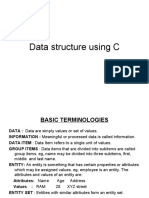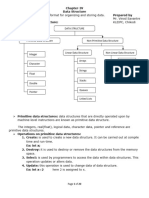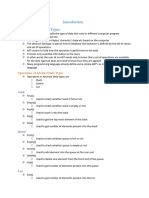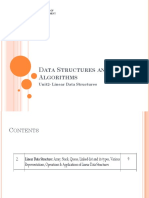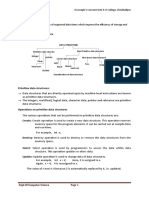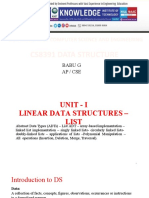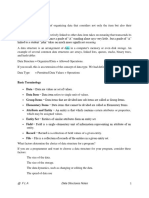0 ratings0% found this document useful (0 votes)
31 views40 pagesDs Notes
Ds
Uploaded by
Soumyaswarup MohantyCopyright
© © All Rights Reserved
We take content rights seriously. If you suspect this is your content, claim it here.
Available Formats
Download as PDF or read online on Scribd
0 ratings0% found this document useful (0 votes)
31 views40 pagesDs Notes
Ds
Uploaded by
Soumyaswarup MohantyCopyright
© © All Rights Reserved
We take content rights seriously. If you suspect this is your content, claim it here.
Available Formats
Download as PDF or read online on Scribd
You are on page 1/ 40
Aait
SYLABUS Shee ears)
BE 2106 DATA STRUCTURE SYLLABUS (3-0-0) THEORY PAPER
(B.TECH ,SECOND SEMESTER)
Module-1! [12 hours]
Introduction to data structures: storage structure for arrays, sparse
matrices, Stacks and Queues: representation and application. Linked lists:
Single linked lists, linked list representation of stacks and Queues. Operations
on polynomials, Double linked list, circular list. .
Module -1l_ [12 Hours}
Dynamic storage management-garbage collection and compaction, infix to
post fix conversion, postfix expression evaluation. Trees: Tree terminology,
Binary tree, Binary search tree, General tree, B+ tree, AVL Tree, Complete
Binary Tree representation, Tree traversals, operation on Binary tree-
expression Manipulation.
Module -IIl [12 Hours]
Graphs: Graph terminology, Representation of graphs, path matrix, BFS
(breadth first search), DFS (depth first search), topological sorting, Warshall’s
algorithm (shortest path algorithm.) Sorting and Searching techniques ~ Bubble
sort, selection sort, Insertion sort, Quick sort, merge sort, Heap sort, Radix sort.
Linear and binary search methods, Hashing techniques and hash functions.
ey
INTRODUCTION TO DATA STRUCTURE
Definition: The logical or mathematical model of a particular organization of data is called q
data structure.
Or
The organized collection of data is called data structure,
Classificatio
Data structure
|
jug ee: RR
Primitive Data structure Non-Primitive Data structure
Int Float Char Pointer Array Uist Files
i ar
ea
Stack Queue Graph i
Primitive data structure:- These are basic structures and are directly operated upon by the
machine instruction. These in general have different representations on different computers.
Integers, floating point numbers, character, string and pointers.
Non-Primitive data structure:-These are more sophisticated data structures. These are
derived from the primitive data structures. The non-primitive data structure emphasize on
structuring of a group of homogeneous (same type) or heterogeneous (different type) data
items. 3
Example: Array, List and files
Linear data structure: A data structure is said to be linear if its elements form a linear
sequence. In the linear data structures processing of the data item is possible in linear fashion,
'e. data can be processed one by one sequentially. There are two ways to represent a linear
(data structure) information in memory.
i) By contiguous memory location.
ii) By pointers and links.
Linear data structure contains following types of data structures.
‘Array, Stack, Queue, Link list
Non-Linear data structure: A data structure in which insertion and deletion is not possible
called non-linear data structure. Non linear data structure contains
in linear fashion
following type of data structure.
Tree, graph.
Data structure operation:
The possible operations on the linear/non-linear data structure a
1. Traversing: Accessing or visiting each record exactly once so that certain items in
the record may be processed.
N.B:- A record is a collection of fields, a
information a file is a collection records.
2, Searching: Finding the location of the record with a given key value.
3. Inserting: Adding a new record to the structure.
fields is a single elementary unit of
4. Deleting: Removing a record from the strus ture.
5. Sorting: Arranging the 1 al order.
6. Merging: Combining the records in two different sorted files into a single
sorted file.
Definition of Algorithm
An algorithm is a finite set of instructions that are
Particular task. Each instruction tells what task has to be performed,
Or
It is a clearly specified set of instructions to be followed to solve a
Characteristic of an Algorithn
Input: it should have zero or more output.
Output: the algorithm should return at least one output,
Definiteness: each instruction is clear and unambiguous,
Finiteness: if we trace out the instruction of an algorithm, then for all cases the algorithm
terminates after a finite number of steps,
Effectiveness: Each instruction must be sufficiently bi
pen can carry it out ina finite time.
‘Time Complexity:
The time complexity of ai
completion as a function o!
Space Complexity:
The space complexity of an algorithm is the amount of memory it needs to run for completion
mn of its
to be carried out in order to solve a
problem
so that person using paper and
algorithm is the amount $f computer time it needs to run for
input size.
of a funct put size,
Example:
Without loop
Intsum,Lj.Kb.....t3 0
Sum=itj+.....44; 1
Tim
Space=11*2=22 bytes.
Loop
For(i=1 to 10) "
Sum=sum+I; 10
Time=21
Space=2*2=4bytes
Therefore we conclude that from above example
1
Time Complexity ¢ ———_—
Spacecomplexity
Array:
An ee is a collection of similar data items it is also known as linear data structure. There
exists a linear relationship between array elements. The array elements lie in the computer
memory in linier fashion. If we chose the name A for the array then the elements of A are
denoted as bracket notation A[0},A[1]....A[n]
The syntax to define an array i
Data type Array_name[SIZE];
Example: int A[20];
Memory Representation of a Matrix: ,
Like one dimensional array, matrices are also stored in contiguous memory locations. There
are two conversion of storing any matrix in memory.
i, Row major order.
ii, Column major order. ;
sments of @ matrix are stor
major order el
then in 2
-olumn
ulation of Matrix elements
In Row
of I" row
column by ©
ed in a row by row basis, ie. all the elemeny,
n major order elements are storeq
row and so on. Similarly in columt
eet
jajor Onder:
i
Bowox starts from O fi
Hinde SALI address+(i no, of columns +j)*w
Adgresjaress-location of the 1” element in matrix
se : :
Bae ade eet ofthe elements{ example: iit then w=2)
from 1
address of A[2][3]=b+(2*10+3)*2=b+46
Column-Major-Order:
If index starts from 0
Ifindex starts from 1
of (A[iJ[))=base address'((i-1) *no, of columns +(j-1))*¥
-xample: tn oe
Consider a matrix of 1010 ie, no, of column is 10 and no, of. Row is 10. To find out
Address of (A[i][j])=base address+(j *no. of Rows +i)*w
Address of (A[i][])=base address +((j+1) *no, of Rows +i+1))*w
Example: i -
Consider a matrix of 1010 i.e. no. of column is 10 and no, of. Row is 10. To find out the
address of A[2][3]=b+(3*1042)*2=b+46
Insertion:
This operation is used to insert an element into an array provided that the array is not full.
Algorithm:
Step 1
Set ismaxsize
Step 2.
Repeat step 3 and step 4 until i>pos-1
Step
AliI=AGi-1]
Step 4:
for(i=n;
Ali-Ali-1];
A[pos-1]=item;
Where n: The no. of element inserted into the array,
Pos: position where data to be inserted,
Item: element to be inserted,
Progran
void main()
f
int arr[20].n,
clrscr();
printf("\nEnter the array size: "):
scant("%d", en);
printf("\nEnter the array elements");
for(i=0;i
Hdefine size 10
int top=-1;
int stack[size];
void push);
jetions are mae
d del
and deletion are
n whit » opposite order.
emoved in the OPP’
be eres stack is at the top of
ation in a
tack.
5 set, tower of
‘TOP which contains the
stack and assign into variable
Example: +ab, *xy
Infix expression to prefix polish notation using bracket { J to indicate a partial translation,
Example:
1) (A+B)te = [FAB] "c= *+ABC
2) A+(B*C) = A+ [*BC] = +A°BC
-ABJ/[-CD]=/+AB-CD
[-AB]*[/DE] = *-AB/DE
}+G= (A+ BD))/-EF}+G
3) (AtBY(C-D)
4) (A-B)(DE)
5) (A+BED VIE:
tra BD|/-EF}G
AP BD-EF]}+G = +/+at BD-EFG
When the operator symbol is placed after
ix expression or reverse polish expression.
Postfix expression (Reverse Polish Notation
‘two operands then the expression is called pos
Example: AB+, CD-, EF*, GH/
‘One never needs parenthesis to determine the order of operation in any arithmetic
expression written in reverse polish notation. This notation is frequently called postfix or
suffix notation.
Note:- The computer usually evaluated an arithmetic expression written in infix notation
in two steps.
1. It converts the notation to postfix notation.
2. Then it evaluate the postfix expression,
Translate Infix to postfix by inspection:
1, (A-B)*(D/E)=[AB-]*[DE/]=AB-DE/*
2. (A¥BtD)/(E-F)}+G=(A+[BDt ])/[EF-]+G=[ABD #)/[EF-}+G= [ABD 4EF-/}+G
= ABDI +EF-/G+
A‘(B+DY/E-
F*(G+H/K)=A*[BD+]/E-F*(G+[HK/])= A*[BD+)/E-P*[GHK/+]
[ABD+*}/ E-F*[GHK/- [ABD+*E/]-[ FGHK/+*]
-ABD+*E/FGHK/+*-
‘Translate Postfix into its equivalent infix expression:
P:12,7,3,-,251,5,585¢
PH12(7-2)/,2,1,5,495¢
= (12/(7-3)), 2,154,
(12/(7-3)), 2,145], +
= (12(7-3)),2*(145)).+
=(12/(7-3))+ (2*(145))
‘Transferring Infix expression to Postfix expression using stack
/* Algorithm for reverse polish(Q,P)*!
Suppose Q is an arithmetic expression written in infix notation. This algorithm finds the
equivalent postfix expression P.
Step I:
PUSH “( “into the TOP of the stack and add *)” to the end of the Q.
Step 2:
Scan © from left o right and repeat step 3 10 step 6 foreach element of Q until the stack
is empty.
Step 3:
Ifan operand is encountered, add it to P
Step 4:
Ifa “(is encountered push it onto stack,
Step 5:
If an operator® is encountered then:
a) Repeatedly POP from the stack and add to P each operator ( on the top of the stack)
which has the same precedence or higher than the operator®
b)_ Add the operator to the stack.
Step 6:
Empty [ABEDFEF-
Program: WAP to translate an infix expression 10 postfix:
#include
#include
char stack{30}; int top=-1;
int precedance(char c)
inta;
switeh(©)
case"): a=0:
break;
case '(: a=15
break:
case “!: a=2;
break;
case 20>)
return a;
void main()
char in{50},p{50}:
int HO;
clrser();
print{("enter an in fix notaion: ");
in);
sca
top++
stack{top]=(;
I=strlen(in);
in{!])'
j-0:
while(top!=1)
iffisalphaCin[i}))
top;
plil=inlil
ins
else iflin{iJ-"0)
{
topt+s j
stack{top}=inli};
else iftin[i] 9)
, 4
[ Symbol scanned
iia Bs] K
2 6
si 2
4 +
3"
6 12
x 4
8 L
9 Ie 37
10D) aa
Program: WAP to evaluate a postfix expression
#include
#include
#include
void main()
int stack{20],top=-1,num,i=0,4,B;
char s[20];,
clrser();
printf("Enter the postfix expression \n"):
scanf ("%s",s);
while(sfi]!=\0")
iffisalpha(sfi)))
th
printf("enter the value of %e: ",sli]):
seanf{"%d" &num);
top++;
stack{top]=num;
iH;
}
else
i
switch(sfi))
a) Repeatedly pop from stack and a p
Re a and add 10 P each operator which has the higher
b) Then add® to stack
Step 6:
Ifa “(* encountered then
a) Repeatedly POP from stack and add to “P “
peers add to“P” until a)” is encountered,
Step 7:
Exit
Example:
Convert the following infix expression to prefix expr
Oe RE a prefix expression using stack
__[ Symbol scanned xpression(P) |
1 H iz
[a +
(Si wee G ae
[a ~
jed[os a ama
| T mo)
{7 + ye
8 P yee HGTP
9 ¥ Dat HGTP al
10. N yet
in * De 4 |
(12) M ye [HGTPNtM. |
13 ( ye HGTPN* Me Be
7 $ yee HGTPNY Ms |
15 Ce ye HGTPNT M*+C
16 | * yet HGTPNS MC
eat = 0 HGTPN® M74CB
[sy Fe yet HGTPN* M*+CB** |
197 a =a HGTPN*MECBA |
Lol CT epry 7 THGTeNEMs+cBe*At |
The required prefix notation result:
Pop all the symbols of expression P and print the result
P: +-+A**BC+*Mt NPTGH
Evaluation of prefix expression:
Algorithm:
This algorithm finds the value of an arithmetic expression written in prefix notation
Step 1:
Add a “(“ at the beginning of P
Step 2:
Scan P from right to left and repeat step 3 and step 4 for each element of P until “¢* is
encountered.
Step 3:
Ifan operand is encountered, put it on the stack.
Step 4:
If.an operator is encountered then: h Bech
a) Remove the top two elements of the stack where A is the top element and B is the
next top element.
b) Evaluate A® B
¢) Place the result back on the stack.
Print"\n1. Insert");
Printf("\n2. Delete");
2. An output restricted Dequeu
It is a Dequeue which allows insertion at only one end of the list but allows deletion at
Of) Bike eet
front ae,
Algorithm for Insertion in Dequene:
Step I
[Check overflows condition]
Ifrear=n-1 and front=0 then
Print “OVERFLOW” AND Return
Step 2:
[Check front pointer value]
If front>0
Front=front-1
Else
Return
Step 3:
[Insert element at the front end]
Qffront]=value
Step 4:
[Check rear pointer value]
Tf rear<(n-1)
rear=rear+1
else
Return
Step 5:
[Insert element at the rear end)
Qfrear=value
Step 6:
Exit
Algorithm for Deletion in Dequewe:
Step |
[Check underflows condition]
Ifrear=-1 and front= -1 then
Print “UNDERFLOW” AND Return:
Step 2:
[Delete element at front end]
If front>-1
value=Qffront]
Return value
Step 3:
[Check Queue for empty]
If{front—=rear)
front=rear=-1
else
front=front+1
Step 4:
[Delete element at rear end]
ifrear-l
value-Qfreat]
Return value
ae Queue for emPts]
front Tea)
Front=rear—
Else
Rear-rear-l
step 6:
Exit
Program:
elements such as each element has been :
ich elements are deleted and processed co
jority Queues:
re Queues is a collection of
priority and such that the order in whi
rules: i
ined Rae of higher priority is processed before any element of lower prio
2 Two element of same priority are processed according to the order in r
added to the queue. :
Example:
Timesharing system in which the processes of higher priority is executed
of lower priority. There are two type of priority queue
1. Ascending priority queue: an ascending priority queue is a collectio
which items can be inserted arbitrarily and from which only the small.
removed.
2. Descending priority queue: A descending priority queue is similar but <
of only the largest item. ae
Program: WAP to implement Queue in Priority
#include
#inelude
#include
#define SIZE 5
int front=-1,rear=-
struct que
{
int info,pr;
}x{SIZE];
Void main()
{
void ins(void),
Void del(void):
Void view(voidy;
int choice;
char ¢;
clrser();
do ;
{
Print("\nt Insert
Prin nd Delete
Print{"\n3. View
LINKED LIST.
A linked list or one way list is a linear collection of
inear collection of data elements, called nodes where
linear order is given by means of pointer Ina linked lisreachvode hactwerpaee ee
1, Information oa
2. Pointer to next node
The last node of the list contains NULL in the pointer field. The pointer contains the address
of the location where next information is stored. A linked list also contains a list pointer
called START which contains the address of 1" node in the linked list, if there is no node in
the list the list is called NULL list or empty list
caer Node Patol. chon Nodes
T[ a0 [2000] [0 |] 3000] sf 50 | 4000} ofa0_| MULE]
Y
Information part M
Pointer to next node
Single linked list
Double linked list
Circular list
header linked list
Operation:
-—— Insert at beginning
|___» insert at end
| _+ insert after a given node
{___+ insert at a specific location
Insert
[—— Insert at beginning
|» Insert at end
[insert after a given node
|__+ insert at a specific location
Deletion
‘Traversing: (Displaying)
Insert at beginning:
Sa a [a0 [et feo [so [eet]
20
P aaa
20
Algorithm:
Step 1:
START holds the address of the 1" node.
Step 2: .
Create a new node and allocate space to it.
Struct node *P;
P=getnode( );
/*P=(struct node*)malloc(sieof(struct node));
If P==NULL i
Then print “Out of memory space” and exit
Step
info(P) = value;
/*P->info=value;*/
Step 4:
Link(P)-START
Step 8:
Temp>>next=P;
Step 9:
it
Insert after a given node:
ran ;
Et fe To} fae ge liaany ou
a
Step 1:
START points to the 1" node
Step 2
[Declare a temporary pointer]
Struct node *temp;
intitem, value;
Step 3:
Temp=START temp points to 1" node
Step 4
While(tempinfo!=item)
temp=temp>next
step 5
[Create a new node]
Struct node *P;
P=(struct node*)malloc (sizeofistruct node));
If P==NULL
Then print “OUT OF MEMORY” and exit
Step 6:
P>info=value
Exit
Insertion at a specific location:
Pah
Step 1: ‘
START points to the 1" node
Step 2:
pointer]
[Declare a temporary
Struct node *temp:
int loc, value,
Step 3:
Temp=START
Step 4:
While(inext!=NULL)
tempI=temp
temp=temp next
)
Step 7:
templ->next=NULL
step 8:
free(temp)
step 9:
exit
Deletion after a given node:
[starry te
wo Lo} fo [od fo ot alo 14)
—
fremp g” [remp .”
Step 1:
START points to the I** node.
Step 2:
If START =NULL
‘Then print UNDER FLOW “and exit
Step 3:
[Declare a temporary pointer]
Struct node *temp,*temp|;
Step 4
Jitemp points to 1" node
While(temp>>info!=item)
temp=temp->next
Step 6:
temp!=temp->next
step 7:
temp->next=temp! next
step 8:
free(temp!)
step 8:
Location 3
exit
fi ‘a specifica Location 3 12123,
Deletion of a node at a specific location fee ee
Eats He 4 bas |
[remp 5. / Tremp} /
Step 1:
TART
Step 5
While(temp!=NULL),
If{temp> info
Print“The item
‘Count=count+1
temp=temp->neat
tem)
Present at position count” and exit
Step
Print
step 7:
llement is not in the list”
Stack using linked list:
1. Push operation using linked list:-
The algorithm is based on the assumption that TOS points to the head(START) of the
linked list and TOP is equal to NULL if the list is empty.
PUSH: Inserting item at the beginning of the linked list.
Fa mete
Te
TOP.
ere
Algorithm:
Step I:
TOP points to 1* node.
Step 2:
[create a new node and allocate space to it]
Struct node *P;
P=(struct node*)malloc(sizeofistruct node));
ULL)
OUT OF MEMORY” and exit
Step 3:
2. POP operation using linked list: ‘
POP: Deletion from the beginning of the linked list.
Step 7:
P>info=value
Step 8:
P>next=NULL
Step 9:
REARnext=P
Step 10:
REAR=P
Step 11;
Exit
Queue deletion using linked list:=
Deletion is just to delete the 1" node, ie. the node pointed by the front pointer,
ee al
elf ao [Nutt]
Algorithm:
Step 1:
FRONT points to I* node,
Step 2:
If FRONT==NULL
| Then print “UNDER FLOW” and exit
Step 3:
[Declare a temporary pointer]
Struct node *temp;
Step 4:
‘Temp-FRONT
Step 5:
FRONT=FRONT> next
Step 6:
Free(temp)
Step 7:
ing of two linked li
pal weme30
a ee ee
am
* 6
Teme | [TEMP
Algorithm:
Step 1:
START points to first node of list
Step 2:
Struct node *temp,*temp]:
int item;
Step 3: d
Read the item from which the list to split
Step 4:
‘Temp=START
Step 5:
Ifjtemp-info!=item)
temp=temp>next
step 6:
tempI=femp>next
step 7:
temp nex-NULL
step 8:
ing the node value in a single linked list:
:
See
10
Algorithm:
Step I:
START points to first node of list
Step 2:
[declare two pointer to structure]
Struct node *temp,*ptr;
Step 3:
temp=START
Step 4:
While(temp->nex
t
Pirtemp->next
While(ptr!=NULL)
t
mua info)
NULL)
Tp=temp-> info;
Temp>info=ptr> info
Ptr info=p
}
Ptr=ptr->next
}
Temp=temp->next
step 5:
exit
Reversing a single linked list:~
:
20 7
se) = iy
Algorithm:
Step 1
START points to first node of list
Step 2:
[Declare four pointer to structure}
Struct node *temp,*curr,¥
Step 3
Temp=START
Step 4:
If(temp>next
Then EXIT
Step 5:
curr=temp
step 6
pre
step 7:
curr->next=NULL
step 8:
while(prev->next!=NULL)
A
Ptr=prev->next
Prev->next=curr
Cur=prev
Prev=ptr
5
Step 9:
Prev->next
Step 10:
START=prev
Step II:
Exit
prev,*ptry
surt->next
You might also like
- CBSE Class 12 Computer Science Arrays Linked ListNo ratings yetCBSE Class 12 Computer Science Arrays Linked List5 pages
- Notes On Data Structures and Algorithms: Dr. Anindita KunduNo ratings yetNotes On Data Structures and Algorithms: Dr. Anindita Kundu64 pages
- Lecture # 1 Data Structures and AlgorithmNo ratings yetLecture # 1 Data Structures and Algorithm40 pages



















